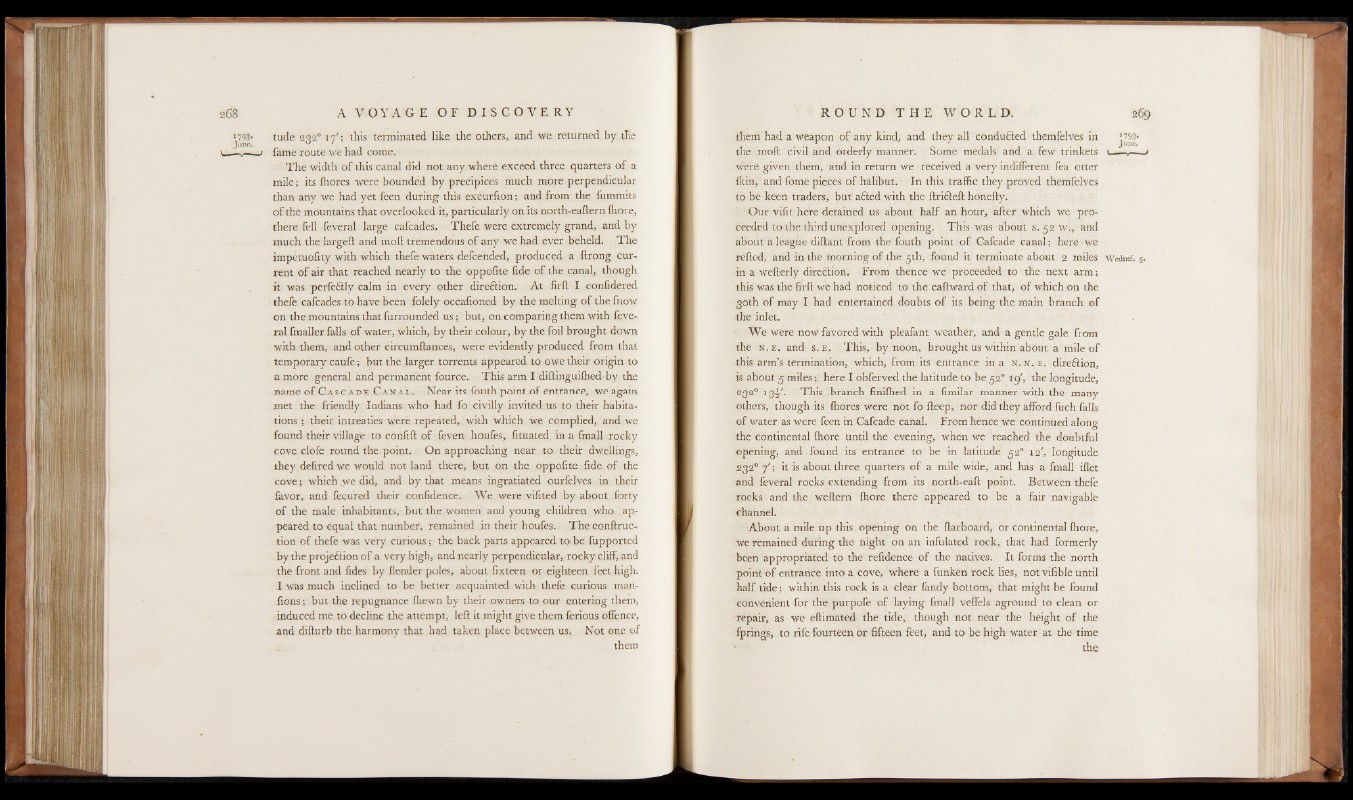
»793- tude 2Q2° 1 7 '; this terminated like the others, and we returned by the
June. u '
— ' fame route we had come.
The width of this canal did not anywhere exceed three quarters of a
mile; its fhores were bounded by precipices much more perpendicular
than any we had yet feen during this excurfion; and from the fummits
of the mountains that overlooked it, particularly on its north-eaftern lhore,
there fell feveral large cafcades. Thefe were extremely grand, and by
much the largeft and moll tremendous of any we had ever beheld. The
impetuofity with which thefe waters defcended, produced a ftrong current
of air that reached nearly to the oppofite fide of the canal, though
it was perfeftly calm in every other direction. At firft I confidered
thefe cafcades to have been folely occafioned by the melting o f the fnow
on the mountains that furrounded u s ; but, on comparing them with feveral
fmaller falls of water, which, by their colour, by the foil brought down
with them, and other circumftances, were evidently produced from that
temporary caufe; but the larger torrents appeared to owe their origin to
a more general and permanent fource. This arm I diftinguifhed by the
name o f C a s c a d e C a n a l . Near its fouth point of entrance, we again
met the friendly Indians who had fo civilly invited us to their habitations
; their intreaties were repeated, with which we complied, and we
found their village to confift of feven houfes, fituated. in a fmall rocky
cove clofe round the point. On approaching near to their dwellings,
they defired we would not land there, but on the oppofite fide o f the
cove; which \ve did, and by that means ingratiated ourfelves in their
favor, and fecured their confidence. We were vifited by about forty
of the male inhabitants, but the women and young children who appeared
to equal that number, remained in their houfes. The eonftruc-
tion of thefe was very curious; the back parts appeared to-.be fupported
bv the projection o f a very high, and nearly perpendicular, rocky cliff, and
the front and fides by (lender poles, about fixteen or eighteen feet high-.
I was much inclined to be better acquainted with thefe curious man-
fions; but the repugnance Ihewn by their owners to our entering them,
induced me to decline the attempt, left it might give them ferious offence,
and difturb the harmony that had taken place between us. Not one of
them
them had a weapon of any kind, and they all condufted themfelves in
the moft civil and orderly manner. Some medals and a few trinkets
were given them, and in return we received a very indifferent fea otter
flan, and feme pieces of halibut. In this traffic they proved themfelves
to be keen traders, but" a£ted with the ftrifteft honefty.
Our vifit here detained us about half an hour, after which we proceeded
to the third unexplored opening. This was about s.52 w., and
about a league diftant from the fouth point o f Cafcade canal; here we
refted, and in the morning of the sth, found it terminate about 2 miles
in a wefterly direction. From thence we proceeded to the next arm;
this was the firft we had noticed to the eaftward o f that, o f which on the
30th o f may I had entertained doubts of its being the main branch of
the inlet.
We were now favored with pleafant weather, and a gentle gale from
the n . e . and s . e . This, by noon, brought us within about a mile of
this arm’s termination, which, from its entrance in a n . n . e . direClion,
is about 5 miles; here I obferved the latitude to be 52° 19', the longitude,
232° 13—'. This branch finifhed in a fimilar manner with the many
others, though its fhores were not fo fteep, nor did they afford fuch falls
of water as were feen in Cafcade canal. From hence we continued along
the continental fhore until the evening, when we reached the doubtful
opening, and found its entrance to be in latitude 32“ 12', longitude
2320 7'; it is about three quarters of a mile wide, and has a fmall iflet
and feveral rocks extending from its north-eaft point. Between thefe
rocks and the weftern fhore there appeared to be a fair navigable
channel.
About a mile up this opening on the ftarboard, or continental fhore,
we remained during the night on an infulated rock, that had formerly
been appropriated to the refidence o f the natives. It forms the north
point of entrance into a cove, where a funken rock lies, not vifible until
half tide; within this rock is a clear fandy bottom, that might be found
convenient for the purpofe of laying fmall veffels aground to clean or
repair, as we eftimated the tide, though not near the height o f the
fprings, to rife fourteen or fifteen feet, and to be high- water at the time
- the
Wednef. 5.